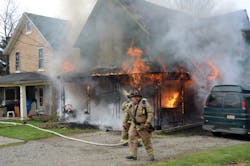Fire Safety Education: Preventing Electrical Fires During the Holidays - Part 1
It is believed that electrical fires cause more damage than all other fires combined. During the holiday period, people use more electrical devices than any other time of the year. Most of that is in the form of decorations, but there is also an increase of electrical devices that did not occur in years past. Many fires occur because of overloaded circuits, worn-out wiring or appliances, lack of maintenance or using electricity improperly.
Learn before you teach
To teach civilians how to prevent electrical fires, you must have a basic understanding of electricity.
The movement of electricity is known as an electric current. Current is described as alternating current (AC) or direct current (DC). AC is commonly found in homes and buildings; the current goes back and forth. DC goes in one direction from positive to negative. Vehicles and many small devices use DC.
Measurements of electricity are “volts,” which is electric potential. In a water-flow analogy, volts of electricity are like water pressure. Ampere, better known as “amps,” is the amount of electricity passing a point in a certain amount of time. Compared to water, it would be called gallons per minute. Watts is the unit of power that compared to water would be gallons.
As with pumping water at a fire scene, the science of hydraulics is applied to get the correct fire stream or quantity of water on the fire. You must follow certain factors when using electricity as well. When you don’t use the correct hydraulics, you have an insufficient fire stream or a hose burst. With electricity, you either have an appliance that doesn’t work or in the worst case, a fire occurs.
The travel of electricity is accomplished through wiring. “Wire gauge” is the measurement of the size of wiring. This is a very important item as many times people use an insufficient wire gauge. Sizes run from 0 and up. The smaller the gauge number, the larger the diameter of the wire. Common sizes are 14 for homes, 10 for larger appliances and 18 for lamp cord (to light one light bulb).
As there is friction loss with water, the same occurs with an electric current through wiring. Friction loss or resistance in wiring creates heat that can become extreme, causing the insulation to melt and in turn starts a fire.
As in hydraulics, if you want larger quantities of water, you go to a larger-diameter hose to cut friction loss. With electricity, using a smaller-gauge wiring (which is actually larger) allows more current to flow through, preventing resistance.
Most common during holidays is improper use of extension cords or overloaded circuits. The extension cord must always have a smaller gauge (which is larger) than the appliance or lighting you are using. If using a string of lights that has 16-gauge wiring, you should use a 14-gauge extension cord. Remember, as with hose lays, the longer the lay, the more the friction loss. If your extension cord must be 50 feet or longer, you should go to two lower wire gauges.
If you require more amps than the wiring was designed for, heat will once again be present. Wall outlets usually have two sockets. Many times, people will use “power strips” with six sockets, which now increases the load for that outlet to eight. Sometimes, people will have two strips on one outlet, making for 12 sockets.
If the amp load is exceeded, it can cause a fire if proper safety protection devices are not used. Those devices include:
• Circuit breakers or fuses – If the amp load is exceeded on the circuit, or a short circuit occurs, the breaker will shut off or the fuse will blow out, stopping the flow of electricity. This is an indicator that a potential fire existed. If not corrected and you reset the breaker or change the fuse, a fire is an extreme possibility.
• Arc fault circuit interrupter – This is a new device that has recently been added to electrical safety devices. Essentially, the device detects a spark and immediately shuts off the circuit. This is much more sensitive and faster than a circuit breaker.
• Ground fault circuit interrupter (GFCI) – It should be used anytime electricity is being used near water or wet areas. This device prevents people from being electrocuted while using an electrical device if it comes in contact with water. A GFCI should be used on all outside decorations.
• Surge protector – This is an appliance designed to protect electrical devices from voltage spikes. Voltage spikes can start fires in delicate electrical devices such as TVs or computer equipment. Anytime your power goes off and then back on, a power surge occurs.
Next: How to prevent help fires
